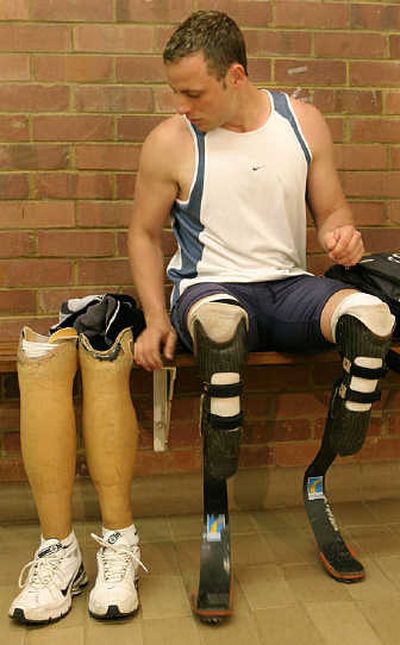Amputee takes bold stance

LONDON – Oscar Pistorius, a double-amputee who races on carbon fiber blades attached below his knees, will get a chance to prove himself against the best runners in the world.
The 20-year-old South African will run the 400 meters at the Norwich Union Grand Prix in Sheffield on Sunday in a field that includes Olympic champion Jeremy Wariner.
Also entered are former Olympic relay gold medalist Darold Williamson of the United States, Commonwealth Games 400 champion John Steffensen of Australia, and former 400 Olympic hurdles champion Angelo Taylor.
“I’ve been chucked in the deep end with the best guys in the world,” Pistorius said Tuesday. “There’s a lot to learn.
“There never has been a Paralympic sprinter to fuse the gap between able-bodied and disabled sport. The next single amputee runs about 48 meters behind me on the 400 and the next double amputee runs about 110 meters behind. So for me to break into this field is unique.”
Pistorius will get a first taste on Friday, when he runs in the second-tier “B” 400 race at the Golden League meet in Rome.
Pistorius was born without fibulas – the long, thin outer bone between the knee and ankle – and was 11 months old when his legs were amputated below the knee. He began running four years ago to treat a rugby injury, and nine months later won the 200 at the Athens Paralympics.
He has gone on to set world records in the Paralympic 100, 200 and 400, but wants a new challenge.
Pistorius was given permission to race in able-bodied races by the International Association of Athletics Federations last month, but still faces a struggle to take the step up to Olympic level amid claims the curved blades he runs on create an unfair advantage.
“We just want to work with the IAAF and get this thing behind us,” Pistorius said. “It has created a lot of negativity that we obviously get frustrated about. I’d like to see what tests they’d like to do and I’d comply with those tests.
“There’s absolutely no reason why they should keep me from running. These prosthetics have been around for 14 years, the exact same design. There’s never been an amputee to run close to my time.”
Pistorius has been running in meets with able-bodied athletes in his native South Africa for the past three years. In March, he finished second in the 400 at the South African Championships.
His best in the 400 is 46.56 seconds and he hopes to break 46.0 on Sunday. Five years from now, Pistorius wants to run sub-45 times.
Wariner has the fastest 400 time this year of 44.02, and Steffensen’s best time in 2007 is 45.07. Michael Johnson holds the world record of 43.18.
To make next year’s Olympics in Beijing, Pistorius would have to run a 46.3 before the July 2008 qualifying deadline – and get IAAF approval.
When not racing, Pistorius wears prosthetics to fit his muscular frame, and normal shoes.
Each racing foot is made of about 50 to 80 layers of curved carbon fiber and weighs almost 4 pounds.
Pistorius has attached a strip of sole from a pair of Nike running spikes to the bottom of the blade, but it doesn’t have a heel, so he struggles to stand for long periods while wearing his racing legs, called Cheetahs.
“It’s a passive foot,” he said. “The energy that you give to compress the prosthetic isn’t the same as what it gives out, so it definitely does not give me an unfair advantage.
“If they ever could find evidence, then I would stop running. It’s not something I would want to compete at if I knew I had an unfair advantage.”